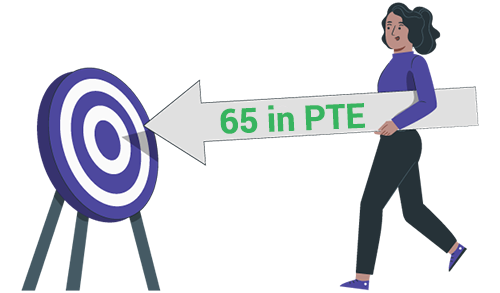Speaking is one of the easiest sections to score 90 on in PTE Academic test; you have to do simple things like reading a passage, or hear and repeating a sentence.
While preparing, you memorise by heart the PTE exam format. You have templates for speaking item type like Describe Image and Retell Lecture. You give a mock test every week. And, you are ready to rock out at the PTE test centre.
Yet, many students fail to reach the target speaking score in spite of complete confidence in their preparation and speaking skill. They are flabbergasted when every other test taker gets their desired score, leaving them wondering where they made a mistake.
“PTE’s algorithm, which is based on artificial intelligence, is often a mystery to students.”
Now we’ve all heard the term artificial intelligence multiple times, but most of us have no idea what it means.
To begin, it means that an algorithm, not human grade test-takers’ results. In PTE Academic speaking you have to give your answers in a microphone. You hear a short tone, and the recording opens. You work hard to give your answer in a fluent speech, you try to use unfamiliar words, and you try to break your response in meaningful chunks.
Once the recording closes, you move on to the next question. From there it is the duty of Pearson’s artificial intelligence to evaluate your recordings.
Now for a speaking item type like repeat sentence scoring is pretty straight forward, they check how many words you spoke in the correct order, and you get points according to that.
But for other item types like Re tell Lecture, a lot goes under the surface.
An introduction to artificial intelligence
scoring refers to how your English language skills are measured by an algorithm that mimics how human evaluators would give you the score if they analysed your responses.
It means Artificial Intelligence compares your response to previously submitted responses. There is a pool of responses for all languages, and the AI gets better every day as more responses are added to the pool.
How does AI determine the correct pool?
The question that arises is how AI will decide on the appropriate comparison pool. That is an easy question to answer. Even before you spoke, you told AI what language pool to use—feeling confused?
When booking the PTE Exam, PTE asks what language the language test-takers usually speak at home, and that is how language pools are determined. Therefore, it is important to choose that language carefully.Here’s a screenshot for the same.
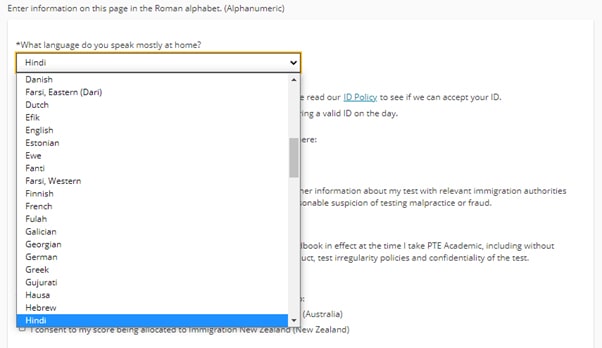
Before we dig deeper, one last thing:
“Artificial intelligence grades you only on what you say!”
Not on what you may have missed. In due course, we’ll be able to exploit this gold mine.
A quick reminder
scores PTE Academic, not humans. In many places, teachers and instructors still evaluate students, but this never happens in a real PTE Academic exam.
This mini course on PTE speaking is divided into three sections:
- How is the PTE Academic speaking score calculated?
- How is fluency marked on the Pearson test?
- How to increase your fluency score in PTE?
How are PTE speaking test scores calculated?
Pearson gives PTE ten scores, but CELPIP or IELTS only provide four scores. All English Language Tests have four scores in common: Speaking, Writing, Reading and Listening. The six other enabling skills that PTE awards help in understanding how PTE speaking test is evaluated. They are oral fluency, pronunciation, spelling, vocabulary, grammar, and written discourse. Here we are focusing on Speaking score, it is determined by oral fluency and correct pronunciation. Having narrowed it down to two scores, we need to ask which is more critical: pronunciation or fluency? Well, the key is fluency.
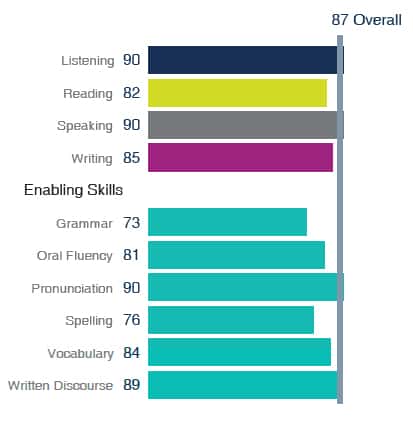
Speaking score is determined by oral fluency and correct pronunciation. Having narrowed it down to two scores, which are more critical: pronunciation or fluency? The key is fluency.
Students often wonder how much fluency is essential. In fact, it completely takes back seat for PTE Repeat Sentence and Answer Short Question, as the content is more important there. Still, fluency is no less important. Using Big Data and Artificial Intelligence, we could then determine that fluency is 1.75 times more important than pronouncing words. What does that actually mean? In other words, if you reach 90 in speaking, oral fluency must be 90, but your pronunciation can be as low as 68. If it falls below 68, then your speaking section score will start dropping. Now that you have an idea of basics—let’s dig deeper.
How does PTE software score fluency?
Many students already have an idea of the importance of fluency, and they think it has to do with speaking loud and fast. That’s so, isn’t it? The answer is a resounding no!
What is fluency then?
In order for your response to be fluent, it should demonstrate a smooth, effortless, and natural pace of speech.
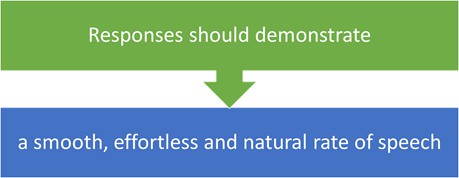
- Rhythm
- Phrasing
- Stress
The scoring of fluency is determined by smoothness of the following things:
According to the AI algorithm, the best (90 points) responses are natural and delivered at a constant rate of speech. Take care of: hesitations, repetitions and false starts since these can negatively affect your speaking score.
Let’s consider an analogy to understand fluency. Consider that you’re driving a car. You’re allowed to drive the vehicle at 30 km/h or 80 km/h. But at top speeds, you will have to apply more breaks than usual, which will make it hard to maintain a steady speed. However, if you travel at 40 km/h or 60 km/h, you may drive at a constant speed without stopping as often. We can interpret the driving as your speaking skill while breaks are fumbles or hesitations or breathlessness. I hope you got my point!
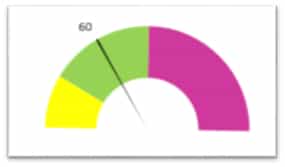
Fluency doesn’t mean speaking at a fast pace or high pitch. Now I’m going to introduce you to a new term: pitch. What’s a pitch? Pitch is a way of describing the degree of highness or lowness of a tone. PTE’s software calculates fluency scores based on the following parameters:
- Rate: the pace (speed) of your speech
- Pitch: the loudness or softness of your sound
- Speed: the speed or pace of your speech
- Pause: The average pause between words or after sentences.

If you meet the following criteria, AI rates you as a fluent English speaker:
- Speak at a constant pace (but a bit quicker)
- No unnatural pauses
- No fumbling
- Neither too fast nor too slow
- no repetitions or hesitations
- no false starts
Now that the basics have been discussed, it’s time to learn about fluency scoring system of the Pearson test.
9 Bands
You receive nine bands or 86+ points in fluency if you meet three crucial criteria:
- The rhythm and phrasing of your speech are smooth.
- You speak without hesitating or repeating words.
- There haven’t been any false starts.
8 Bands
Even one mistake in PTE can lead to significant penalties. Even one hesitation or repetition, or one false start on the PTE’s speaking algorithm results in a PTE score below the threshold of 79+. Thus, the criteria for eight bands are:
- you speak in an acceptable rhythm.
- The word choice and phrasing are appropriate.
- There is only one instance of hesitation or repetition or false start.
7 Bands
PTE’s algorithm does not award more than seven bands when you do not speak at a constant pace as it considers your speed uneven. Regardless of speaking at a constant pace, but hesitant at times or a few repetitions, you will snag 65 points for speaking section.
Another vital aspect of 65+ in speaking is that between words or sentences, you should never have a long pause. So, to summarise, seven bands in speaking are when:
- the speed is acceptable but uneven
- there are more than one hesitations, repetitions, or false starts
- no prolonged pauses
6 Bands
In PTE speaking, you will receive 58+ PTE score when you speak at an uneven pace. The second essential criterion to consider is that your response should only include two or three hesitations or repetitions or false starts. One long pause is allowed for six bands, but not more than two. To summarise for six bands:
- you speak unevenly.
- No more than 2-3 repetitions or false starts or hesitations.
- a single long pause
Anything that is not included in the above six band criteria falls into 5 bands.
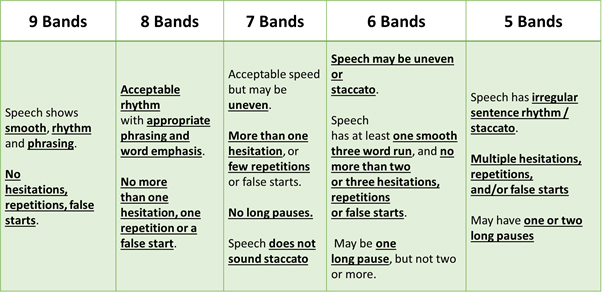
How can I improve my fluency score in the PTE?
Now that you have extensive knowledge on fluency scoring let’s look at getting the maximum score in PTE Speaking.
Never ever speak for humans, but always speak the way the PTE’s algorithmic AI robot will grade you. The PTE speaking algorithm is somewhat like a software. Why do we say this? Because software requires some input values that should be within a certain range. Your response will not be graded if you speak outside a given limit. PTE’s algorithm will check for the following in your response to determine your oral fluency score:
- pitch
- pace
- Pause
The importance of these metrics above cannot be underestimated. For PTE fluency or pronunciation, you may have seen students score 10 points, which is equal to a 0.
“How is it, they may have spoken, still got 10 marks for fluency or 10 points for pronunciation.”
Did you ever wonder why? The PTE algorithm cannot comprehend what they are saying since they spoke outside of the range of the algorithm’s range. Let’s start by asking: What ranges do they have, and how are they measured?
Marvel PTE to the rescue
Marvel PTE’s artificial intelligence-powered software comes to your rescue here. We are using the same technology that Pearson uses to assess your speaking responses.
First things first
I want to remind you about the pool PTE has for grading your responses. At Marvel PTE, the same pool exists, and when you sign up, you choose the language you speak at home so that our AI can ensure that you are rated accordingly.
Below is the screenshot showing the language you will choose when setting up your profile.

Once you have selected the language, our AI will begin assessing you accordingly. Next, let’s talk about metrics. In our software, when you speak your responses, our artificial intelligence will analyse the pitch, tone, pace, and pauses. We have the following meters in our software to evaluate your speaking abilities:
This meter measures your pitch and tells you whether your pitch is within the acceptable range of PTE’s algorithm. Now, how do you know whether you are speaking correctly or not? If the majority of your response is within the green zone, that means that you are speaking within the acceptable range. Here’s a screenshot of a student speaking within the range. The pitch of your voice is measured throughout your response.
Examples of what your pitch should not be:
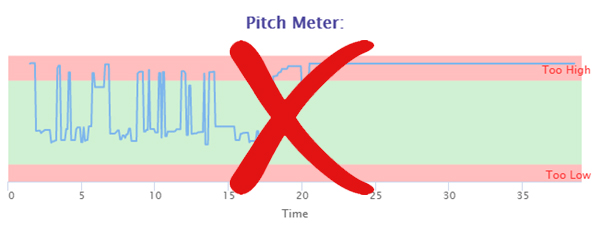
You can have your pitch like this:
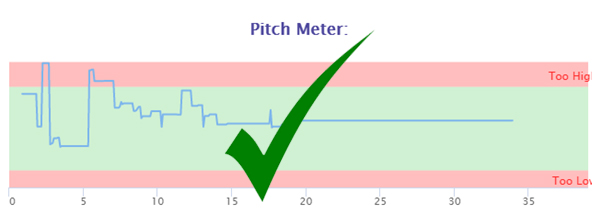
This meter measures the pace at which you speak. When you speak way too slowly or too quickly, your speech falls in the red zone. PTE’s algorithm assumes that you are not speaking fluently if you are speaking too slowly. When you speak too fast, the software cannot understand your words, and you will score lower on fluency. Therefore, it is important to speak within the range.
Here are the screenshots of the accepted range:

This meter measures the average amount of pauses you take. Remember, the long pause is an essential criterion in determining your PTE score. Our software can help you determine your average pauses and ensure you don’t exceed the green limit.
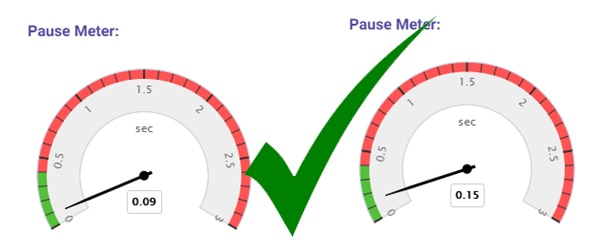
Okay, so these three metrics are very valuable for making sure that you speak within Pearson’s AI algorithm for speaking. However, staying within this range does not guarantee a high fluency or speaking score. Marvel PTE’s software makes it very simple to improve your speaking scores. We are also using artificial intelligence; thus big data analysis could help us determine the ranges that Pearson’s PTE algorithms use. All three metrics: pitch, pace, and pause are determined while you record your response in real-time.
Once your microphone is configured and optimised, then you can easily experiment with these factors to find how you can stay within the range.
How does Marvel PTE help you improve your fluency and speaking scores?
Marvel PTE software helps you improve your speaking score in all 3 stages of your response. Now you must be wondering what 3 stages? The answer is:
- First Stage: before you record your answer
- Second Stage: while you record your answer
- Third Stage: after recording your answer
First Stage:
Most PTE candidates are aware of the fact that there are two timers when recording your PTE speaking responses: preparation time and recording time. Preparation time is the time when you prepare to record your answer. For example, read aloud’s preparation time is 30 seconds or 35 seconds or 40 seconds. It is completely determined by the length of the text, which can be up to 60 words. Our students who receive coaching from us understand the importance of preparation time and are properly equipped with a plan to make the most out of it. PTE Read Aloud give you marks in both the speaking and reading sections, so scoring well is extremely important.
By now, you know that speaking scores are based primarily on fluency scores. Below is a brief explanation of read aloud scoring:
Below is a summary of PTE read aloud:

Fluency in read alouds can be improved by not fumbling or hesitating when you are speaking words. Now, how are you going to ensure this doesn’t happen since you know that the algorithm in PTE takes a lot of notice of how many repetitions you make or the number of hesitations you have while recording your response?
Pronunciation and Definition Suggestions:
After working with students from all over the world, we have learned how hard it is to speak correctly tricky words when you are not proficient in the English language, which most PTE test-takers aren’t. That’s why we have a helpful feature that allows you to listen to the pronunciation of words and know their meaning (which allows you to have a better vocabulary). Then, during the preparation time, you can practice the correct pronunciation for the words, and this will help you significantly in reducing your repetitions or fumbles or hesitations.
Second Stage:
Once you are fully prepared for speaking read aloud, now is the time to record your response. There are 2 ways to do it:
- Timed Mode
- Untimed mode
These modes are useful to improve your fluency and can be switched on or off before you begin practising for read aloud questions on the PTE speaking section. Let’s first understand what these modes are.
- Untimed mode
If you are just starting out with your preparation for PTE, you might need more preparation time than what the real PTE Academic exam provides you. In the practice section, the timed practice is disabled by default.

You can prepare for any amount of time, and then once you are ready; you simply need to click the start answer button in our software as in the picture below.
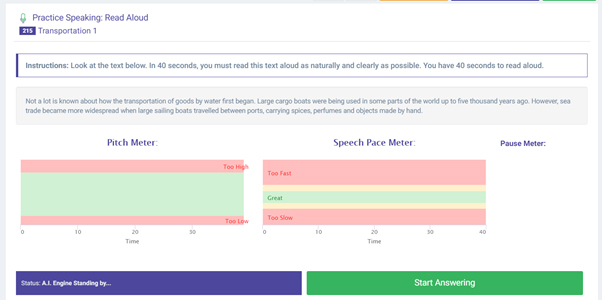
- Timed mode
Once you have practised enough or get close to your PTE exam, you can always select the timed mode. This is important to practice within the timeframe and then record your responses based on the suggested time and strategies we teach at Marvel PTE in order to get the desired score.
When you enable the time mode, you’ll see a timer on the screen. Our AI engine will allocate 30/35/40 seconds of preparation time based on the prompt’s length. Below is a screenshot of the preparation time:

After the preparation time is over, the AI software will start recording your response, and you will see a recording timer appear.

Turning the time mode on or off:
The time mode can be manually managed by clicking the time mode button. You can find it in the index of any question type in PTE Speaking. Here is a screenshot to find time mode button.

Third Stage:
Once your response has been recorded, you need to analyse it to increase your speaking scores. Marvel PTE’s software provides the following metrics to improve your speaking score:
- Fluency
- Pronunciation
- Accuracy (Listening/Reading)
- Pronunciation Comparison with Native English Speaker
- Your Recorded Answer
- 9-Bands Sample Answer
- Explanations
- Send for Evaluation
- Measuring Performance
- Saved Answers
Let’s look at each feature individually:
Fluency
Fluency is a very important metric when it comes to speaking, and you’ll get fluency scores for each attempt in Marvel PTE’s software, as you can see in the screenshot.

Our software will give you scores on fluency from 10 to 90, and it is a skill you will gradually learn over time by practising multiple times. Just remember that speaking fast won’t guarantee you a higher fluency score, but speaking at a constant rate gets you there. There are multiple strategies that students can use to boost their fluency scores, for instance, the OSOB rule, with which they saw an improvement of up to two bands in speaking.
There are a few important rules for speaking fluently:
OSOB Rule
The most important rule for getting the desired score in the PTE exam is the OSOB rule. This is one sentence in one breath. Speak one complete sentence in one breath, without pauses or chunking. And what about lengthy sentences? For them, you need to practice and build your lung capacity. You may pause at commas, but do not change your pace.
Now let’s see what scores you get for your PTE read aloud based on our strategies. Watch how important it is to practice on a platform and the right way to score good marks in PTE speaking.
Pronunciation
A further important component in every speaking item type is pronunciation, and similar to fluency, you receive pronunciation scores after each attempt, as in the screenshot below:

Accuracy
There is a colour guide to make understanding the scores easier:
PTE speaking awards marks to both Reading and Listening. For example, in Read Aloud you get scores for speaking and reading, and in PTE Repeat Sentence you get scores for speaking and listening. Many students know PTE speaking scores are important but don’t realise the mistakes they are making, which can affect their reading and listening content scores.
Our accuracy scores are useful in situations like this. Our Artificial Intelligence software compares the responses you have spoken and gives you a score as in the screenshot here.

Green: the words you have spoken correctly are highlighted in green, and they match the text
Red: words you have mispronounced or that you missed while speaking.
Blue: the words that you have added.
Our software allows you to compare individual words, which helps in understanding which words you need to focus on more and which words you have pronounced correctly. You have noticed that you have spoken incorrectly, and now the question arises of how to correct pronunciation? Our next feature will come in handy here.
Pronunciation Comparison with Native English Speaker
Our AI engine compares how you pronounce words to a native speaker’s pronunciation. You can hear any word and then correct your pronunciation based on the comparison between how a native English speaker would speak that word and how you are saying it, as demonstrated by the screenshot below:
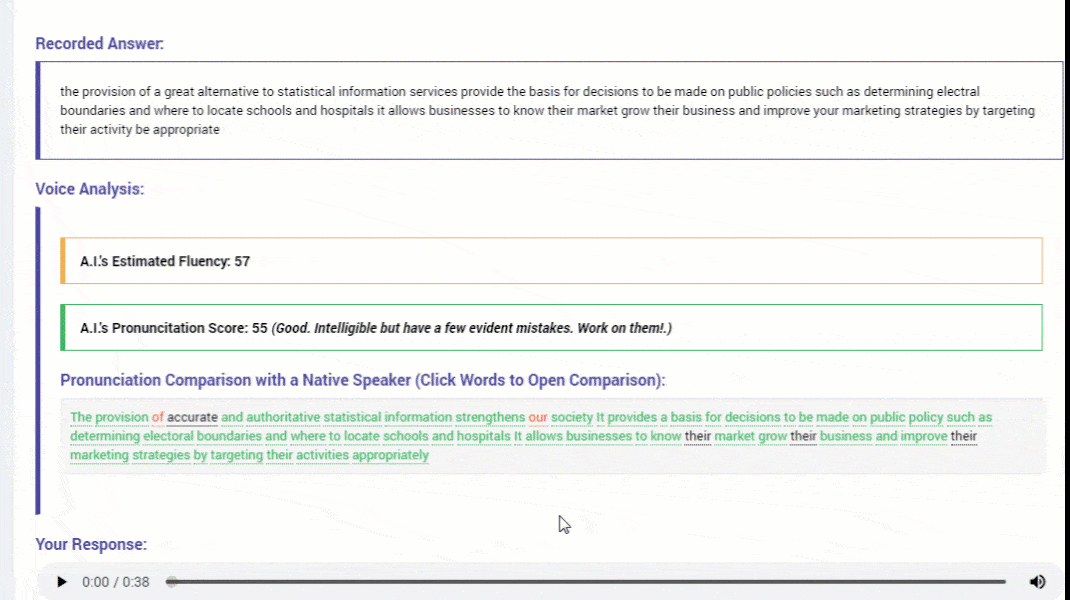
How does this feature work? As the screenshot indicates, certain words are orange, a few are red, and many are green. The red and orange ones are the ones that you have to work on.
Click on any word, and you will see the correct pronunciation along with quality (which is a comparison between how you speak and how a native speaker would speak). The blue icon allows you to hear your voice and the magenta icon allows you to listen to that of the native English speaker.
Playing both of them one-by-one multiple times can help you see what mistakes you have made and how to improve your pronunciation.
Your Recorded Answer
Our software lets you listen to your answer multiple times, so you can hear how you have recorded it. This way, you can verify that you followed OSOB rules if you fumbled or repeated, and then you can fix it by re-recording the answer.

9-Bands Sample Answer
Listen to the sample answer for every speaking item type in my, Bhrat Brij’s voice. It will help you hone your speaking skill so you can get 90 marks in speaking, fluency, pronunciation, reading, and listening. This feature lets you track whether you are implementing all strategies correctly.

Explanations
In our software, all answers are accompanied with explanations where the strategies are highlighted and explained. When read aloud, for example, you can hear which words need to be spoken as plosives. By doing so, you will understand how to implement the strategies in a more accurate manner.

Send for Evaluation
You cannot really improve on your own without expert feedback. This is where our correction service, otherwise known as Send for Evaluation, steps in. Once you have recorded your response, and our AI has analysed it, you may submit your response for evaluation.
Our PTE experts will listen to your answer, give you feedback on how you can improve, and check if you’re applying the strategies correctly. Just fix your mistakes, and you’ll be on the right track to your target score.
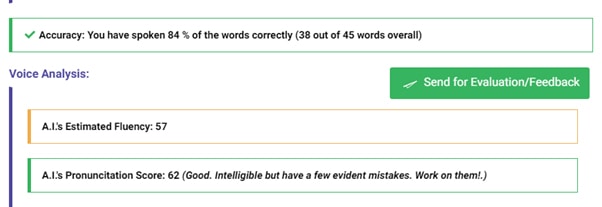
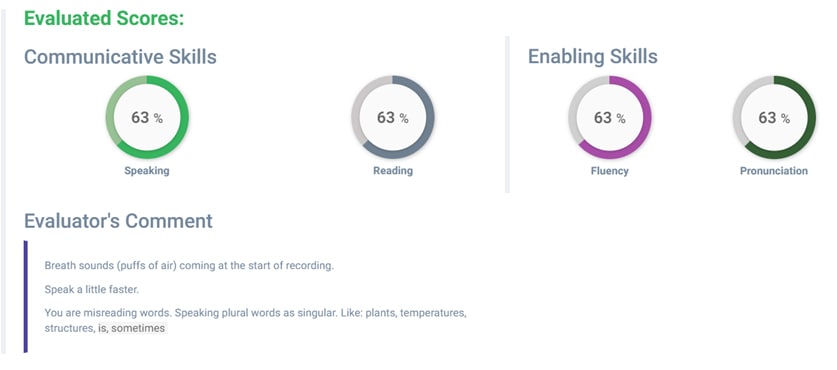
Measuring Performance
An important aspect of improving your speaking is performance measurement. On the table of all questions, you will find the feedback score our team would have given to you. This allows you to easily compare your scores and decide if you have improved.
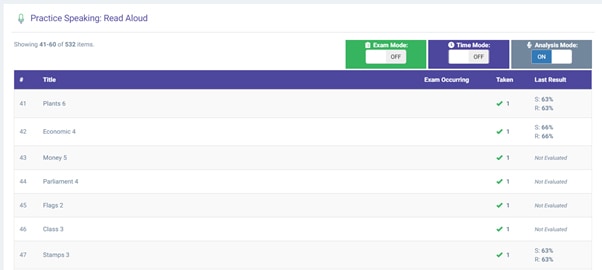
Saved Answers
Our Artificial Intelligence saves all of your responses, as well as the feedback you received. You can always return to them later. This feature is useful when you have to go through your feedback quickly in order to make improvements.

That’s all I could say on how to get 90 marks in your speaking exam. Speaking is one of the easiest sections in the PTE Academic test to score 90. All you need is applying the right strategies and then practising them on a relevant platform, which allows you to test the strategies.
